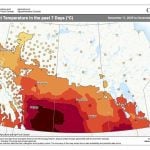What is the old saying? Don’t like the weather? Wait a minute. That seems totally appropriate for our current weather pattern.
We are in a very active pattern as the persistent ridge of high pressure that brought warm fall weather across Western Canada has collapsed and, in its place, we have a large trough of low pressure over western North America.
So far, the main storm track has stayed mostly to our west, or at least far enough west that we have stayed on the warm side of any storm systems lifting northwards. The question is whether we will keep dodging these systems.
Read Also

Farmer gift idea: How about a weather station?
The 2025 holiday season is looming, and a home weather station might make a great Christmas gift for farmers
For the first half of this forecast period, weather models hint at development of a strong Colorado low lifting northeast from a western trough of low pressure around the middle of the week. Consensus is low on how this low will behave, but the models are persistent on the development of the low, so confidence is high that a storm system will develop, just not on where it will track.
It looks like the low may lift in two pieces. The first piece is expected around the start of this forecast period, and may be warm enough for any precipitation to fall as rain. The best chances for rain are over eastern regions, with snow over far western regions.
Then we may see a second area of low pressure track northeast sometime Friday or Saturday. This low will have colder air to work with, so the potential for snow is higher. What is uncertain is just how far east it will track. There is the potential for it to track far enough east that it misses our region entirely.
Once these systems move by, it looks like our weather pattern will settle down for a bit. The models show high pressure building in, bringing with it a return to clear skies and seasonable temperatures. Expect daytime highs to be in the -4 to -2 C range with overnight lows falling to around -10 C. Temperatures will be about five degrees colder if we get significant snow cover.
Usual temperature range for this period; highs: -6 to 6 C, lows: -15 to -2 C. Probability of precipitation falling as snow: 75 per cent.
















